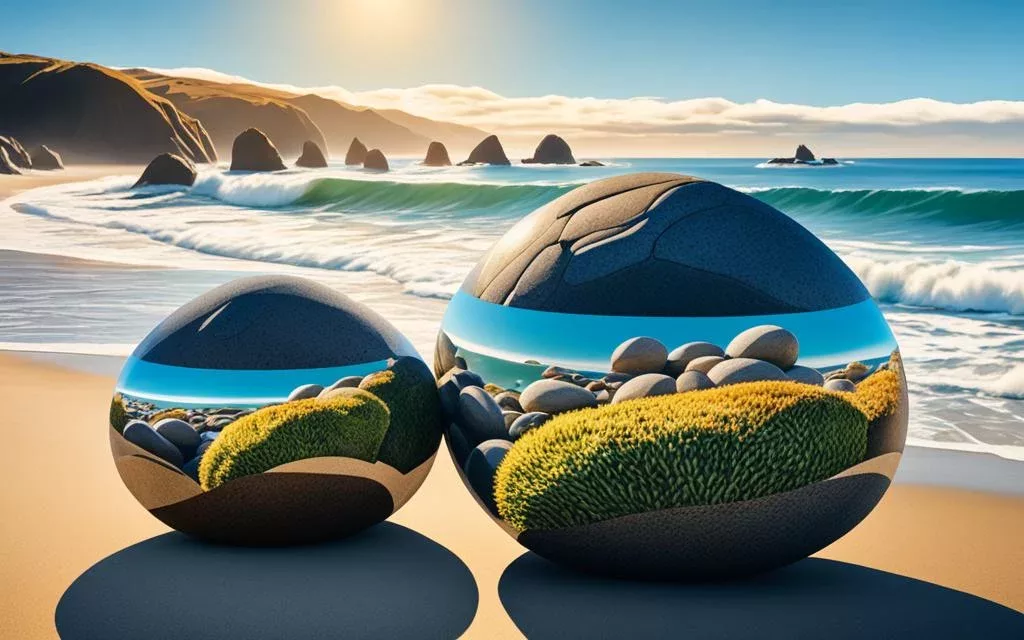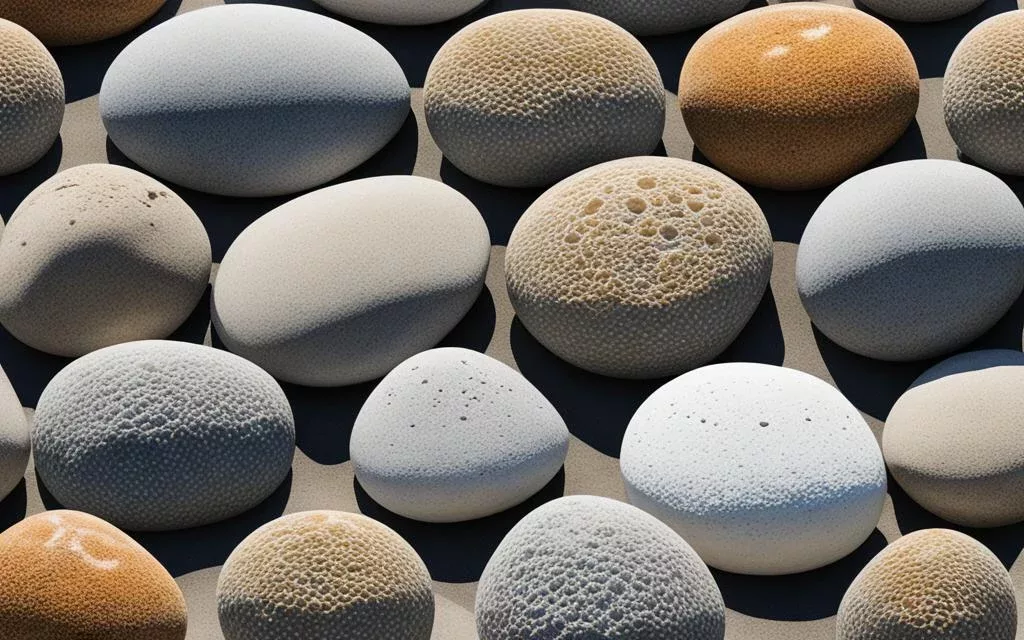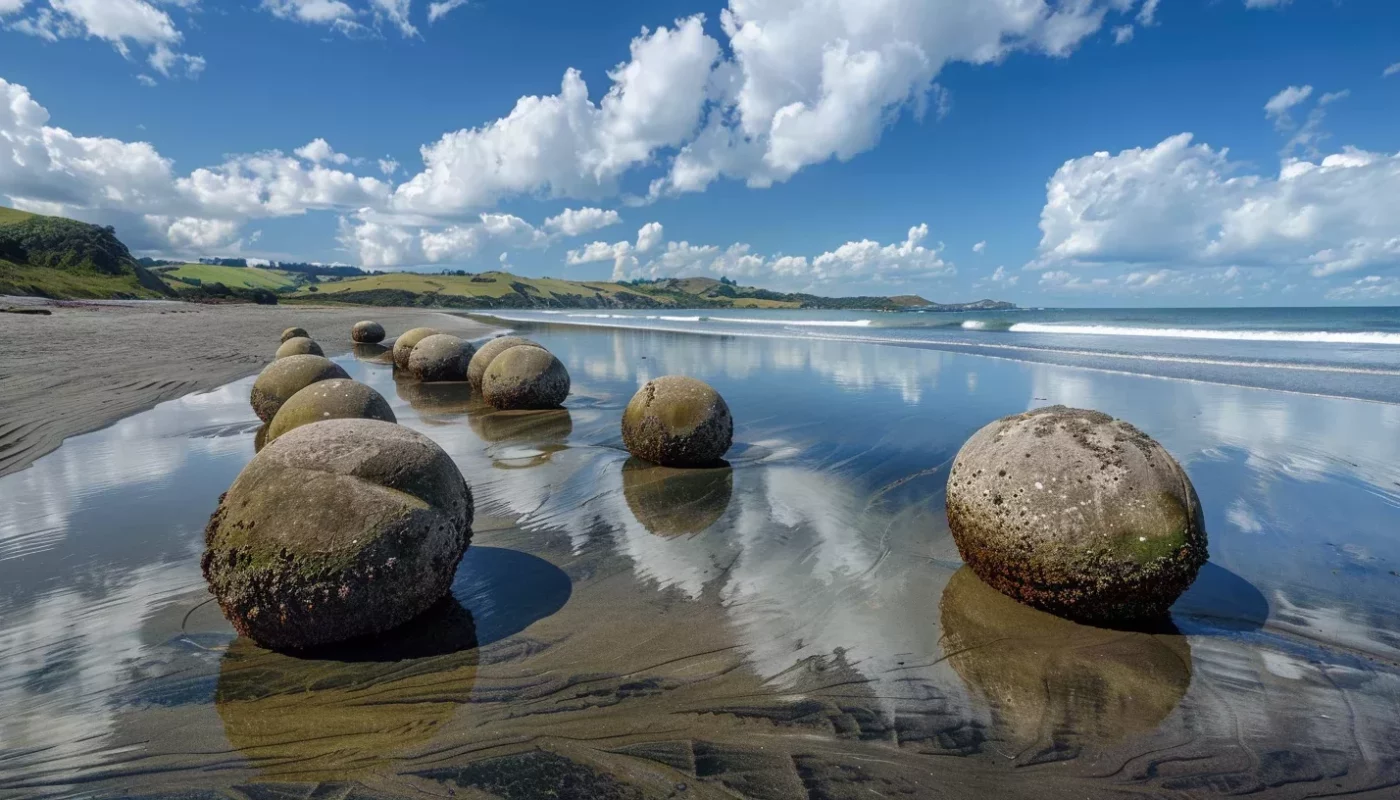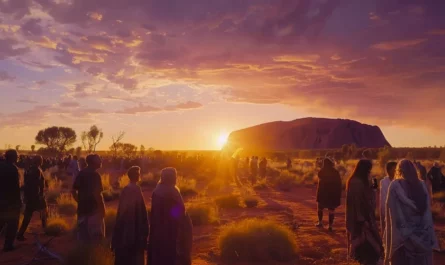Did you know the world’s biggest spherical rocks are in New Zealand? At Koekohe Beach on New Zealand’s Otago coast, you’ll find the Moeraki Boulders. These huge, round stones are scattered along the shore (coordinates: 45°20′42.99″S 170°49′33.82″E). They are a sight to behold, formed by the coastal erosion of mudstone and bedrock. Both tourists and scientists are drawn to their astonishing size and beauty.
The boulders started out as mudstone from the Paleocene era. Over time, coastal erosion shaped them into the large, spherical rocks we see today. They are now an important part of a scientific reserve. People from all over the world come to see these unique formations.
But the Moeraki Boulders are more than just interesting rocks. They are a key part of conservation efforts. As a scientific reserve, steps are being taken to protect them. This way, they will be there for future generations to enjoy.
The Mystique of the Moeraki Boulders
Koekohe Beach is home to the iconic Moeraki Boulders. These landmarks in New Zealand grab everyone’s attention with their mystery. They look like perfect spheres and make people wonder about their origins.
The mystery of the Moeraki Boulders comes from two different stories. Scientific studies say these boulders formed naturally over 65 million years. They are made from layers and cementation in sedimentary rock. This shows how nature creates amazing things along the coast.
Māori legends, however, share a magical story. They say the boulders are from a great canoe, Āraiteuru, that wrecked in New Zealand. The boulders are thought to be what the canoe was carrying. This adds a deep cultural meaning to the natural sights.
Exploring the Moeraki Boulders mysteries is fascinating because of science and folklore. Both explain how these boulders formed and why they’re special. They are a natural wonder and an important part of New Zealand’s history.
It’s very important to take care of the Moeraki Boulders. Doing so lets future visitors see their mysterious beauty. Efforts to preserve them protect not just their looks but also their stories and ecosystem.
Geological Formation
The Moeraki Boulders, located along New Zealand’s Otago coast, are fascinating. They have a unique origin story. These round stones formed from mudstone of the Paleocene epoch, becoming solid through cementation.

The Science Behind the Shapes
Their round shape comes from a special process where calcium acts as glue. Over millions of years, this calcium accumulates around a core. This forms the large boulders we see, showcasing incredible erosion patterns.
Sizes and Shapes
The Moeraki Boulders’ sizes vary a lot, from tiny to huge. They can be from 0.5 to more than 2 meters across. Some are perfectly round, while others are stretched due to how they lay. It took around 4 to 5.5 million years for them to get this big.
Places like the Koutu Boulders and Katiki Boulders also have similar stones. These sites show how unique and consistent the formation process of the Moeraki Boulders is.
It’s vital to keep these ancient stones safe. They are special science reserves, protected from wear and harm. This ensures they’ll amaze people for years to come.
Location and Accessibility
Visitors at Moeraki Boulders find a top sight on Koekohe Beach. It’s set between Moeraki and Hampden towns. These natural wonders are visible and easy for everyone to reach.
Finding the Moeraki Boulders
The Moeraki Boulders are on Koekohe Beach. Paths lead you right to them. Their big, round shapes make them easy to spot and fun to see.
Getting There
Coming from the north or south, New Zealand’s routes offer stunning views. Travelers from Oamaru go along State Highway 1 by the coast. From Dunedin, the view is just as lovely.
These boulders are not to be missed on State Highway 1. They’re perfect for those into geology or who want a great photo. The Moeraki Boulders are truly special.
Keeping these wonders safe is key. We must tour responsibly to save them for later. It’s important to treat the boulders and area with care.
Moeraki Boulders’ Composition
The Moeraki Boulders are fascinating rock formations. They capture the interest of scientists with their unique mineral content. They are made of mud, fine silt, and clay. These are bound together by calcite. The amount of calcite changes from the inside to the outside.

Mineral Makeup
The boulders have a special layering effect because of calcium carbonate. Their hard exteriors come from calcium-rich calcite. As they wear down, the difference in calcite density shows a detailed and attractive composition. This makes them stand out for their cleanliness and geological importance.
Septarian Cracks
The boulders have an amazing feature called septarian patterns. These are big cracks filled with a type of calcite crystal. They make a beautiful mosaic. This unique look has intrigued both researchers and tourists, enhancing the boulders’ appeal.
There are efforts to keep these boulders safe. Conservation is key to keeping them as they are. Learning about their makeup and septarian patterns shows why we must protect them. This way, they can be enjoyed by future generations.
Other Similar Formations
The Moeraki Boulders are not alone. Their unique shape and size can be found all around the world. Spherical stone formations elsewhere reveal the interesting ways they come to be.
In North Island, the Koutu Boulders capture attention. They look like they’re from Mars. They show how coastal erosion and sediment binds together, similar to the Moeraki Boulders.
The Katiki Boulders offer more examples of these cool shapes, found south of Moeraki. Their disk-like form shows how wide-reaching these geological forces are.
“The septarian concretions found in England’s Kimmeridge and Oxford Clays further underscore the global prevalence of these natural phenomena. These formations share striking similarities with their New Zealand counterparts, offering insights into their sedimentary origins.”
Concretions around the world tell a story of natural processes. They help us see the history of our earth. They inspire those who see them.
| Location | Formation | Characteristics |
|---|---|---|
| Koekohe Beach, NZ | Moeraki Boulders | Perfectly spherical, large size |
| North Island, NZ | Koutu Boulders | Spherical, Mars-like appearance |
| South Moeraki, NZ | Katiki Boulders | Disk-shaped, sedimentary |
| England | Septarian Concretions | Cracked, filled with crystals |
Learning about these formations helps us value their importance. Protecting them ensures they’re here for future study and enjoyment. They’re treasures of science and beauty.
Conservation Efforts
The Moeraki Boulders are a top natural landmark in New Zealand. They draw tourists worldwide. Thus, it’s vital to keep the boulders safe. They are known for their beauty and science value. This has made them a scientific reserve. Efforts in New Zealand keep them safe from harm and erosion.
Protecting the Boulders
Many steps have been taken to protect the boulders. A key player is Wilderness Lodge Lake Moeraki. This place has offered guided nature tours for nearly 30 years. The lodge leaders, Anne Saunders and Dr. Gerry McSweeney, have fought to safeguard the wilderness since the 1980s. Lodge guests can join free activities twice a day. These activities teach them about the wildlife and history of Lake Moeraki.
Such efforts are key in protecting natural landmarks. They also help people understand why these places matter.
These teaching programs, with the lodge’s many activities, help save the Moeraki Boulders. They help people appreciate nature more. Visitors see unique things like penguin nests without predators from August to December. The main aim is to educate visitors while keeping the Moeraki Boulders safe.
Here’s a look at what Wilderness Lodge Lake Moeraki does. It helps in protecting natural landmarks like the Moeraki Boulders:
| Activity | Duration | Cost | Season |
|---|---|---|---|
| Guided Nature Adventures | 1 hour each | Free | All Year |
| Penguin Discovery Trips | Variable | Additional Charge | August – December |
| Kayaking Safaris | Half/Full Day | Additional Charge | All Year |
| Rainforest & Coastline Exploration | Half/Full Day | Additional Charge | All Year |
This all-around approach works well. It teaches the public, offers nature activities, and fights for conservation. This ensures the Moeraki Boulders will stay safe and loved in New Zealand for many years.
Local Māori Legends
The Moeraki Boulders of New Zealand are more than just natural wonders. They hold importance in Māori culture, linked to the Araiteuru canoe’s legendary journey. This story is a vital piece of the cultural fabric, with the boulders at Koekohe Beach marking the journey’s end.
Legend has it, the Araiteuru canoe, full of valuable gourds, faced disaster at sea. This led to the creation of the boulders we admire today. They are seen as more than rocks; they are sacred cultural symbols.
Preserving Māori stories is key to keeping their heritage alive. Through stories, the Moeraki Boulders keep this history tangible. They remind us of the wisdom and legacy of the Māori people.
| Aspect | Legend | Scientific Explanation |
|---|---|---|
| Formation | Lost cargo from the Araiteuru canoe | Cementation of Paleocene mudstone |
| Significance | Historical and spiritual artifacts | Geological formations from natural processes |
Keeping the Moeraki Boulders is not just about science. It’s a cultural mission too. Through preservation, we ensure they stay part of New Zealand’s story. This helps protect a cherished narrative for the future.
Tourism and Significance
The Moeraki Boulders attract many people to New Zealand every year. These giant, round rocks are a must-see for tourists. They allow visitors to see one of nature’s amazing creations up close.
Visitor Experience
Upon arriving at Koekohe Beach, visitors are amazed by the Moeraki Boulders. These rocks are not only cool to look at, but you can also learn a lot. People can touch them and take pictures.
There are signs and tours that tell you about the rocks’ history and importance. This makes the visit even more interesting.
Preservation and Interaction
The Moeraki Boulders are very popular, so it’s important to take care of them. There are rules like not climbing on the rocks. This helps keep the beach nice for everyone.
The local community works hard to look after the boulders. They check how people and nature affect the rocks. This helps make sure the boulders stay beautiful and interesting.
Below is a summary of how visitors should behave and what’s being done to protect the boulders:
| Aspect | Description |
|---|---|
| Visitor Experience | Informative tours, educational signage, photo opportunities |
| Interaction Guidelines | Maintain designated paths, avoid climbing on boulders |
| Conservation Efforts | Regular assessments of environmental impact, community involvement |
| Preservation Measures | Balancing access with conservation to minimize ecological impact |
Conclusion
The Moeraki Boulders are a key part of New Zealand’s geological past. They are big, round rocks that appear as the Paleocene mudstone around them wears away. These rocks range in size and took millions of years to form. This shows how nature works slowly to create beauty.
The boulders’ makeup is also intriguing. The edges of the bigger boulders have a lot of calcite. This makes them not just a treat for the eyes but also a magnet for those eager to learn. Places like the Koutu Boulders prove that these geological gems are found in other locations too.
Keeping these boulders safe is very important. Efforts are made to protect them from wearing down too much. This helps make sure they can be enjoyed by people in the future. They are not just amazing to look at but also help us learn about our planet. They inspire everyone who sees them.




